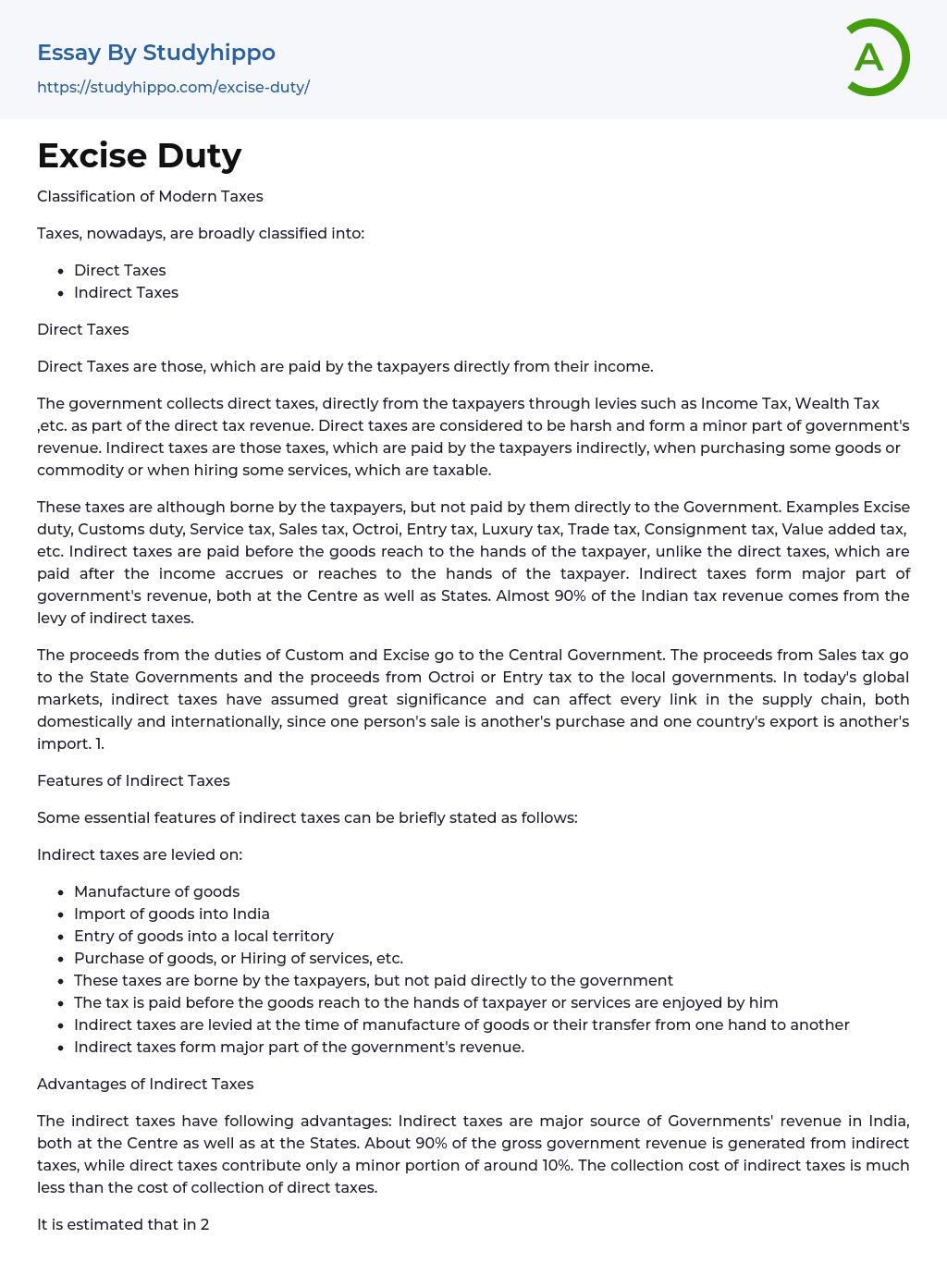Classification of Modern Taxes
In today's world, taxes can be classified into two main types: direct taxes and indirect taxes.
- Direct Taxes: These are the taxes that individuals pay directly from their income.
- Indirect Taxes: These are the taxes that are imposed indirectly on goods and services.
The government collects direct taxes, such as Income Tax and Wealth Tax, directly from taxpayers. These taxes form a minor part of their revenue. On the other hand, there are indirect taxes that include Excise duty, Customs duty, Service tax, Sales tax, Octroi, Entry tax, Luxury tax, Trade tax, Consignment tax, Value added tax (VAT), etc. These indirect taxes are paid by taxpayers indirectly when they purchase taxable goods or services.
Unlike direct taxes, indirect taxes are paid by the taxpayer before receiving goods and services. These taxes play a crucial role in generating
...government revenue at national and state levels. In India, approximately 90% of tax revenue is derived from indirect taxes. The Central Government is responsible for collecting Customs and Excise duties, while State Governments generate revenue through Sales tax. Local governments receive revenue from Octroi or Entry tax.
Today, indirect taxes play a crucial role in global markets and can impact every aspect of the supply chain, both domestically and internationally. This is because what one person sells, another person buys, and what one country exports, another country imports.
Features of Indirect Taxes
The main characteristics of indirect taxes can be summarized as follows:
- Manufacture of goods
- Import of goods into India
- Entry of goods into a local territory
- Purchase of goods or hiring services, etc.
- These taxes are borne by taxpayers but not paid
directly to the government
Advantages of Indirect Taxes
In addition to being a major revenue source for the Indian government at both Center and State levels, indirect taxes offer several advantages. Approximately 90% of gross government revenue comes from indirect taxes, while direct taxes only account for around 10%.
Indirect taxes are collected at a lower cost than direct taxes. In 2001-2002, approximately 1.05% of the total tax collected was from indirect taxes, while around 1.38% was from direct taxes. Indirect taxes have simpler procedures, easier compliance, and better control, making them less prone to tax evasion compared to direct taxes. Detecting tax evasion is also easier for indirect taxes than for direct taxes. Additionally, indirect taxes help promote industrial growth and attract industries to economically disadvantaged areas through concessions, rebates, and holidays.Customs duties, which are a form of indirect taxes, are crucial for maintaining fair competition in international trade. They align with domestic requirements and help regulate the import of goods into India. By imposing high customs and antidumping duties, the government protects the country's trade and industry. Taxpayers indirectly bear these taxes, minimizing their impact and reducing any potential resistance.
Indirect taxes are paid by taxpayers when they purchase goods or hire services, and they do not consider it an additional payment. As a result, taxpayers usually favor indirect taxes due to their psychological reasoning. Additionally, these taxes help regulate excessive spending by imposing charges on
luxury items like the luxury tax. This approach also aids the Government in controlling industrial growth through demand, imports, and exports management.
Indirect taxes have the advantage of avoiding prolonged litigation, making the process of resolving disputes and reaching settlements easier. On the other hand, direct taxes tend to result in lengthy, complicated, and multiple legal battles. Additionally, the record-keeping for indirect taxes is simpler and more straightforward.
Therefore, manufacturers and traders find it easy to handle, and this also applies to tax administrators who can easily verify and scrutinize records during assessment proceedings. However, the assessees of indirect taxes, such as manufacturers and traders, do not give as much importance to indirect tax planning as they do to direct tax planning.
Therefore, indirect taxes are also favored by manufacturers' psychology.
Disadvantages of Indirect Taxes
The drawbacks of indirect taxes are as follows:
- Indirect taxes are imposed on goods and services, leading to higher prices for goods, commodities, and services. These indirect taxes are commonly referred to as inflationary.
- Indirect taxes increase project costs. Customs duties on imports, excise duties, even on on-site fabricated plant and machinery, sales taxes, etc. raise the cost of a project, including government projects. This necessitates additional financing and diverts investment away from industries.
- Federal government essays
- Armed Forces essays
- Confederate States Of America essays
- Federal Government Of The United States essays
- Fourteenth Amendment To The United States Constitution essays
- Governance essays
- Parliament essays
- Politics essays
- Jurisdiction essays
- Bureaucracy essays
- Separation Of Powers essays
- Congress essays
- President essays
- United States Congress essays
- Non-Commissioned Officer essays
- Appeal essays
- Revenge essays
- Corporate Governance essays
- Public Service essays
- Income Tax essays
- Supply essays
- Red Cross essays
- Democracy essays
- State essays
- Liberty essays
- Absolutism essays
- Reform essays
- Republic essays
- John Marshall essays
- Bourgeoisie essays
- Developed Country essays
- Elections essays
- International Relations essays
- Left-Wing Politics essays
- Monarchy essays
- Political Corruption essays
- Political Party essays
- Political Science essays
- Sovereign State essays
- United Nations essays
- World Trade Organization essays
- Contras essays
- Dictatorship essays
- Foreign policy essays
- Monarch essays
- Corruption essays
- Foreign essays
- Democratic Party essays
- European Union essays
- President Of The United States essays




